Abstract: The objective of this study was to analyze the effect of the quantity and quality of the feed offered on the performance of male beef cattle, >6 months old, on intensive grazing systems in Uruguay. Two hundred and fifty-four results from different experimental trials (nexp=68) performed between 1991 and 2020 by different research institutions in Uruguay were compiled and analyzed. The experiments included feeding studies with cultivated pastures as a single nutritional source (nexp=61), as well as supplementation studies on the same type of pastures (nexp=49). Simple, quadratic, multiple linear regressions and recursive partitions were performed to synthesize the information. Quadratic relationships between forage allowance (fa) and average daily gain (adg) were observed for the different animal categories and seasons of the year. Including other parameters such as initial body weight and supplementation with energy concentrates or silages allowed to predict the adg of animals under a wide range of feeding alternatives. Briefly, low fa levels (≤1.75 %bw) limit animal performance to maintenance gain conditions (0.2 kg/day). To achieve adequate levels of adg (0.6-0.7 kg/day), with a low to moderate fa (between 1.75 to 3.5 %bw), the nutritional value of pasture needs to reach at least level 3 of quality (>58 %odm, >13 %cp, <50 %ndf, >21 %Leg and <19 %dr). These daily gains can be exceeded if the fa is >3.5 %bw (adg in the range of 0.7 to 1.0 kg/day). The increased response in additional adg (0.4-0.5 kg/day) by the effect of supplementation with energy concentrate was achieved with low fa levels (≤2.25 %bw). The prediction of additional adg using a multiple linear regression parameter allows evaluating whether supplementation is appropriate.
Keywords: review, rearing, fattening, supplementation, cultivated pasture.
Resumen: El objetivo del presente trabajo fue analizar el efecto de la cantidad y la calidad de alimento ofrecido sobre el desempeño de bovinos para carne machos, de más de 6 meses de vida, en sistemas pastoriles intensivos de Uruguay. Se compilaron y analizaron 254 resultados de diferentes trabajos experimentales (nexp=68) realizados por distintas instituciones de investigación de Uruguay entre los años 1991 y 2020. Los estudios incluyen trabajos de alimentación con pasturas cultivadas como única fuente nutricional (nexp=61), así como trabajos de suplementación sobre ese mismo tipo de pasturas (nexp=49). Se realizaron regresiones lineales simples, cuadráticas, lineales múltiples y particiones recursivas de modo de sintetizar la información. Se observaron relaciones cuadráticas entre la asignación de forraje (af) y la ganancia media diaria (gmd) para las diferentes categorías y estaciones del año. La inclusión de otros parámetros como peso vivo inicial y suplementación con concentrados energéticos o ensilajes permitió predecir la gmd de los animales bajo un amplio rango de alternativas de alimentación. Brevemente, niveles bajos de af (≤1,75 %pv) limitan el desempeño animal a condiciones de mantenimiento (0,2 kg/día). Para lograr niveles de gmd adecuados (0,6-0,7 kg/día), con af bajas a moderadas (entre 1,75 a 3,5 %pv), se necesita que el valor nutritivo de la pastura alcance al menos el nivel 3 de calidad (>58 %dmo, >13 %pc, <50 %fdn, >21 %Leg y <19 %rs). Esas ganancias pueden superarse si la af es >3,5 %pv (gmd en el rango de 0,7 a 1,0 kg/día). La mayor respuesta en gmd adicional (0,4-0,5 kg/día) por efecto de la suplementación con concentrados energéticos se logra con niveles de af bajos (≤2,25 %pv). La predicción de gmd adicional utilizando los parámetros de la regresión lineal múltiple permite evaluar la conveniencia de la suplementación.
Palabras clave: revisión, recría, engorde, suplementación, pasturas cultivadas.
Resumo: O objetivo do presente trabalho foi analisar o efeito da quantidade e qualidade do alimento oferecido sobre o crescimento de bovinos de corte, machos e de mais de 6 meses de idade em sistemas pastoris intensivos do Uruguai. Foram analisados 254 resultados de vários trabalhos experimentais (nexp=68) desenvolvidos por diferentes instituições de pesquisa de Uruguai no período compreendido entre os anos 1991 e 2020. Os estudos incluem trabalhos de alimentação com pastagens cultivadas como única fonte nutricional (nexp=61) e trabalhos de suplementação sobre o mesmo tipo de pastagens (nexp=49). Para compendiar a informação foram implementadas regressões lineais simples, quadráticas, lineais múltiplas e partições recursivas. Foi observada uma relação quadrática entre a forragem oferecida (FO) e o ganho médio diário (GMD) para diferentes categorias e estacoes do ano. A inclusão de outros parâmetros como peso vivo inicial e suplementação com concentrados energéticos ou silagem permitem predizer a GMD dos animais num amplo intervalo de opções de alimentação. Baixos níveis de FO (≤1,75 %PV) limitam o desempenho animal em situação de mantença (0,2 kg/dia). Para lograr níveis de GMD adequados (0,6-0,7 kg/dia), com FO baixas a moderadas (1,75 a 3,5 %PV), e necessário que o valor nutricional da pastagem alcance pelo menos o nível 3 de qualidade (>58 %DMO, >13 %PB, <50 %FDN, >21 % Leg e <19 %RS). Esses GMD podem ser superados se FO e >3,5 %PV (GMD no intervalo de 0,7 a 1,0 kg/dia). A maior resposta no GMD adicional (0,4-0,5 kg/dia) por efeito da suplementação com concentrados energéticos é obtida com níveis de FO baixos (≤2,25 %PV). A previsão de GMD adicional usando os parâmetros de regressão linear múltipla permite avaliar a adequação da suplementação.
Palavras-chave: revisão, crescimento, terminação, suplementação, pastagens cultivadas.
Animal production and pastures
Estimated beef cattle performance under intensive grazing systems in Uruguay
Estimación del desempeño de bovinos para carne en sistemas pastoriles intensivos de Uruguay
Estimativa do desempenho de bovinos de corte em sistemas pastoris intensivos do Uruguai
Received: 24 July 2019
Accepted: 25 February 2021
Published: 23 April 2021
Corresponding author: jclariget@inia.org.uy

In Uruguay, 89% of cattle fattening is carried out on grazing systems(1), with cultivated pastures being of utmost importance in their feeding. An estimate of 30% of these animals are directly fattened with cultivated pastures(2), and 50% had access to improved pastures at some stage of their life (rearing and/or fattening) so as to have the age and weight demanded by the meat processing industry at slaughter(3). These rearing and/or fattening systems on cultivated pastures are identified as intensive livestock systems and are characterized by being productive systems where high animal stocking rates are managed (generally: 1.0-1.6 lu/ha(4)) with a rearing and fattening period of no more than two years(5). In these systems, the type of grazing acquires particular relevance, especially rotational grazing, since it is more productive than continuous grazing only under high stocking rate conditions(6)(7). The concept of forage allowance (fa), defined as the daily amount of dry matter (kg dm) of offered forage per 100 kg of animal body weight (bw), then acquires more relevance than animal stocking rates. Fractioning forage through the use of daily belts allows managing the forage resource better (greater control of the fa), to regulate the nutritional value of pastures more efficiently, and to balance the diet, as it has greater control of animal intake(6). To estimate the belt size, the dm availability, the fa, and the number of animals(8) should be considered. The number of days that animals will remain in each belt for longer occupations should also be taken into account.
On the other hand, in our country, pasture supplementation has increased as a result of the growth of the agricultural area with greater availability of grains and by-products. Supplementation with hay, silage or grain improves the nutritional condition of the animal(9), which may result in better finishing and carcass and meat quality(10). However, the most important role of supplementation in intensive systems is the increase in animal stocking rate and consequently the overall productivity of the farm. This is due to more rational use of pasture, as well as better use of crops and harvest residues within the system(11).
There are reviews at international level on how the forage offered, and the type and level of supplementation affect animal performance, as well as programs that allow predicting the average daily gain (adg). Nevertheless, these present limitations, since they: 1) do not predict the animal response for a range of feed supply(12)(13)(14); 2) evaluate fa in terms of kg dm of forage/kg of animal bw(15)(16) without considering the time factor (commonly used in continuous grazing); 3) only evaluate the effect of the level and type of supplementation on incremental adg(9)(17); 4) only predict animal performance for tropical pastures(18), or 5) estimate adg, but the user must establish the dm intake(19).
For these reasons, and as a way of generating national coefficients for Uruguayan technicians and farmers, this study aimed to analyze the effect of the quantity and quality of feed offered on the performance of male beef cattle over 6 months old, in intensive grazing systems in Uruguay. These arise from a bibliographic review and an analysis of experimental work carried out in Uruguay which studied how the quantity and quality of the offered feed affect animal performance.
For this research, 68 experimental studies (nexp) on feeding with cultivated pastures (prairie or winter forage crops) as the only nutritional source were used and synthesized, as well as supplementation studies on the same type of pastures, carried out and published by the Agronomy College (Udelar) and inia in Uruguay between 1991 and 2020. Only the tests carried out with meat-breed castrated males over 6 months of age were included.
Trials that presented results of animal performance under different levels of forage allowance and in different seasons of the year were identified among the experimental studies. These (n=125, nexp=61) were analyzed by simple and quadratic linear regressions using the statistical package sas. The seasons of the year were defined as: summer (December, January and February), autumn (March, April and May), winter (June, July and August) and spring (September, October and November).
The correlation was estimated between fa and adg of animal weight in the different seasons of the year for each category (calves and steers). Subsequently, a multiple linear regression analysis was performed using the stepwise sas function where parameters were included to estimate the adg of beef cattle. The parameters were: fa (% bw), category (calves and steers), initial bw (kg), season of the year (summer, autumn, winter and spring), type of supplement (hay, silage and energy concentrates), and type of cultivated pasture (prairie and winter forage crops). A significance ≤0.15 was considered to include the parameters in the model. In total, 254 results were used (nexp=68).
Subsequently, a multivariate analysis was performed with the statistical package InfoStat using the recursive partition methodology, including fa and an index of the nutritional quality of pastures (1=lowest nutritional value, 5=highest nutritional value; table 1). It was estimated based on real laboratory values (organic matter digestibility (omd), crude protein content (cp) and percentage of neutral detergent fiber (ndf)), and when it was not reported it was estimated based on pasture characteristics (percentage of legumes and dry remains), used in the different trials (n=125, nexp=68).
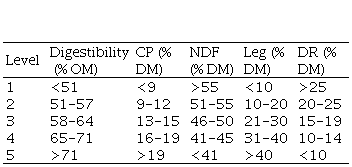
The methodology used allowed to group and characterize the animal response (adg) based on the aforementioned criteria (fa and pasture nutritional value). This methodology is used in human medicine(20)(21)(22) and allows building decision trees that model the influence of a set of explanatory variables on the target variable. Minimum data size of 25% (n=31) was considered to continue partitioning each node. The main results are presented grouped into nodes sharing similar values for some of the evaluated characteristics.
The experimental results of supplementation with energy concentrates carried out in all seasons of the year (n=90, nexp=35) were also analyzed by a multivariate analysis using the recursive partition methodology to evaluate how the fa and the level of supplementation affect the “additional” adg (adga). The adga was calculated as the difference of adg between the supplemented group and the control group (without supplementation).
Additionally, the studies that evaluated the use of forage (percentage of disappeared forage in relation to offered forage) under different levels of fa (n=71, nexp=28) were identified and analyzed using simple and quadratic linear regressions, as well as the level of forage dry matter intake (fdmi) estimated as a percentage of bw (n = 50, nexp = 18). Also, the experimental studies that presented results of supplementation with energy concentrates on cultivated pastures were identified (n=90, nexp=35). For this case, adga was used as a result of supplementation with energy concentrates.
Finally, for the variables fdmi and adga, multiline linear regressions were performed using the stepwise function of sas, considering the following parameters: fa (% bw), animal category (calves or steers), initial bw (kg), season of the year (summer, autumn, winter or spring), and type of pasture (winter forage crop or prairie), and the level of supplementation (% bw) was considered for adga. A significance ≤0.15 was considered to include the parameters in the model.
Table 2 shows the simple and quadratic linear regression parameters by season of the year to estimate the adg of calves and steers. It is observed that the estimated adg has a better fit (higher R2) in quadratic regressions than in simple linear regressions.
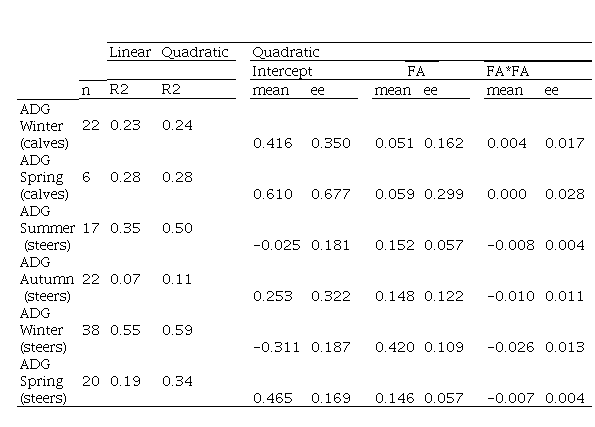
Figure 1 shows the synthesis of the 61 local studies (n=125) using the parameters described in Table 2, where it can be observed that as the forage allowance in cultivate pastures increases, the adg of animal increases but with decreasing rates. In turn, it can be observed that the adg potential for steers at the same fa level is greater for winter and spring than for summer and autumn. In this way, what Carámbula(23) mentions regarding the influence of the advanced phenological state of the pastures in summer (reproductive state) on their quality becomes evident; as well as the reported by Rearte and Pieroni(24) regarding the great proportion of water, low effective fiber level and high soluble proteins/soluble carbohydrates rate in pastures in autumn, determining that the achievable potential based only on cultivated pastures is lower in summer and autumn than in winter or spring. Additionally, during the summer, caloric stress can be another factor that determines the lower productive performance due to a lower dmi(25)(26) and/or a greater maintenance effort to dissipate heat(27)(28).
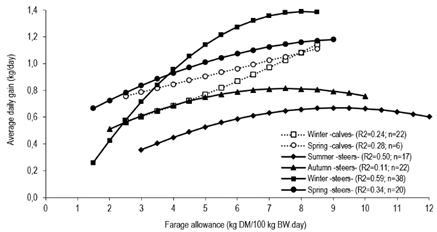
On the other hand, in winter and spring, the adg potential is greater for steers than for calves. This has been published widely by international literature(29)(30)(31)(32) and is due to a greater ruminal digestibility(33), among other things, as a compensatory effect of steers due to some previous restriction(34).
The parameters included in the model of multiple linear regression are shown in table 3. The parameters that affect the estimation of adg the most are supplementation with energy concentrates, fa, and summer (greater R2). Including other parameters such as spring and winter, initial body weight and supplementation with silages allow improving the fit in the estimation of adg. The inclusion of the type of pastures (winter forage crops or prairie) or supplementation with hay were not significant (P-value>0.15) for the developed model.
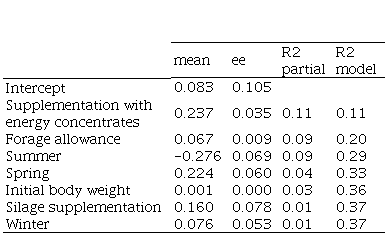
To ratify the use of this model, the results obtained experimentally were compared to the prediction of the model from three studies chosen at random:
1) Risso and others(35), working in winter with steers of 260 kg of bw, supplemented ad libitum with silage from prairie or crops and managed at a fa of 1% bw, reported adg of 0.72a and 0.64a, respectively, while the model estimated an adg of 0.67 kg/day.
2) Beretta and others(36), working in winter with steers of 360 kg bw, managed with a fa of 5 % bw and supplemented at 1% of bw with ground sorghum grain, reported an adg of 1.47 kg/day, while the model estimated an adg of 1.13 kg/day.
3) Beretta and others(37), working in summer with steers of 280 kg bw, managed with a fa of 6% bw reported an adg of 0.48 kg/day, while the model estimated an adg of 0.52 kg/day.
Based on these examples, the model will allow technicians and farmers to predict the expected adg considering the abovementioned parameters (fa, season of the year, initial body weight and supplementation with energy concentrates or silages). In this way, they can model feeding alternatives for animals and evaluate the most suitable for their livestock production system.
The multivariate analysis allowed to generate six nodes or terminal associated groups of adg based on the fa and the nutritional value of pasture (Figure 2). As can be observed, low levels of fa (≤1.75% bw) limit animal performance (0.2 kg/day; Node 1). To achieve adequate levels of adg of weight (0.6-0.7 kg/day), working with low to moderate fa (between 1.75 and 3.5% bw), it is necessary for the nutritional value of pasture to reach at least level 3 (>58% of omd, >13% of cp, <50% of ndf, >21% Leg, and <19% of dr; Node 3). With moderate to high levels of fa (>3.5% bw) weight gains in the range of 0.7 to 1.0 kg/day can be obtained (Nodes 4, 5 and 6). Under moderate to high fa conditions, the nutritional level of forage has a lower impact on adg, possibly associated with the increased selection capacity of animals in those grazing conditions(38)(39).

n = number of observations; ADG = average daily gain (kg/day); FA = forage allowance (kg of DM/100kg body weight/day); BW = body weight; NV = nutritional value (scale 1 – 5; described in Table 1).
The adga of energy concentrate supplementation generated five terminal nodes, as shown in Figure 3. The highest response in adga (0.4-0.5 kg/day; Node 1) was at low fa levels (≤2.25% bw), emphasizing what was reported by Moore and others(9), who found that when the fdmi is lower than 1.75% bw, the supplement has an additive effect. As fa increases (>2.25% bw), the adga decreases (Nodes 3, 4 and 5), highlighting that at higher fa levels the substitute effect of the supplement is greater(9)(40). Under similar fa conditions, the adga due to supplementation increased (0.2 vs. 0.4 kg/day; Node 2 vs. Node 3), with higher levels (0.6 vs. 1.0% bw).
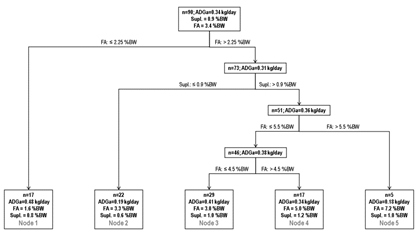
n = number of observations; ADGa = “additional” average daily gain (kg/day); BW = body weight; FA = forage allowance (kg of DM/100kg body weight/day); Suppl. = supplementation.
Figure 4 combined the two recursive partitions previously discussed (Figure 2 and 3). The analysis of adg based on different forage allowances and nutritional values of pastures is shown at the top. The analysis of adga due to supplementation based on different forage allowances and energy concentrates offers is presented at the bottom of the figure. The association of both partitions will allow technicians and farmers to predict the expected adg based on pasture characteristics (quantity and quality) and supplementation level. As an example, we can see that it is possible to achieve adg in animals of around 0.7 kg/day by working with low fa values (1.5-1.6% bw), average nutritional values of forage (2.6; scale 1 to 5), and supplementing with levels of 0.8% bw. However, adg of around 1.2 kg/day can be achieved if we give the steers greater fa (5.0-5.5% bw) with similar nutritional values (3.0; scale 1 to 5) and higher levels of supplementation (1.2% bw).
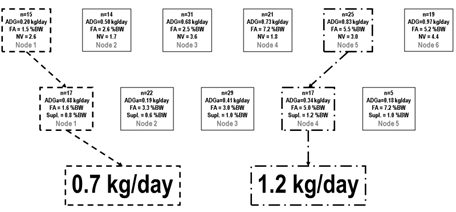
n = number of observations; ADG = average daily gain (kg/day); ADGa = “additional” average daily gain (kg/day); FA = forage allowance (kg of DM/100kg body weight/day); BW = body weight; NV = nutritional value (scale 1 – 5; described in Table 1); Suppl. = supplementation.
Table 4 and Figure 5 summarize the local studies where the allowance, the forage utilization (n=71, nexp=28) and the fdmi estimate (n=50, nexp=18) were recorded. It is observed that forage use has a better fit (greater R2) in quadratic regression, while fdmi has a moderate fit (R2 = 0.39) and not different than the model used. As the fa increases, pasture utilization decreases, reaching values below 40% with fa levels greater than 6.5% of bw. On the other hand, when the fa is lower than 4% of bw, forage use exceeds 60%, being able to reach values of 85% with very low fa (1.5% bw). As for the fdmi estimate, it can be seen that to reach levels above 2% of bw it is necessary to work with fa above 3.5% bw, while it is necessary to work with fa over 6% bw to reach levels greater than 2.5% of bw.
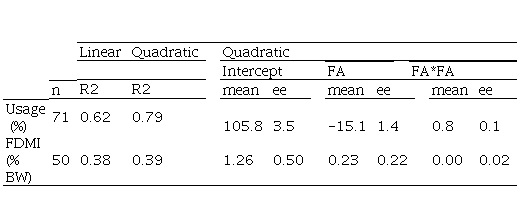
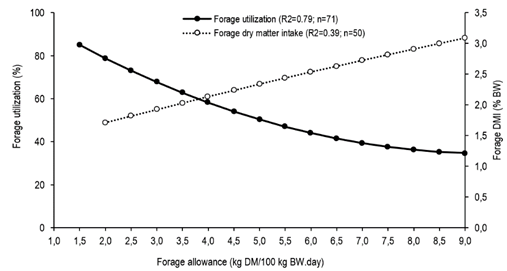
The multiple linear regression using the function stepwise of sas allowed to improve (R2 = 0.66) the estimation of fdmi in relation to the simple linear and quadratic regression (Table 5). It is observed that fa is the most related parameter to fdmi (greater R2), but the inclusion of the season, initial body weight and type of cultivated pasture allows to improve this estimation. The lower fdmi at the same level of fa during autumn and winter could be due to the low content of dm in forage(41). Concentrations of dm below 24% have been reported to increase the number of bites(42). Concentrations below 22% of dm decrease the intake rate (grams of dm/min)(43), while concentrations below 18-20% of dm limit animal intake (kg dm/day)(44)(45).
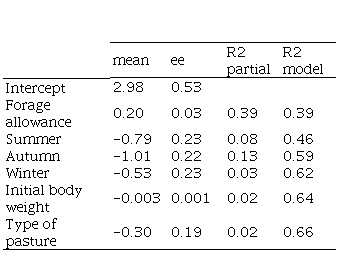
The lower fdmi during the summer may be due to the lower nutritional value of forage. During the summer, the cultivated pastures present the highest values of ndf(23)(46), which is inversely related to the capacity of fdmi(47). Similarly, the lower fdmi when using prairie relative to winter forage crops can be attributed to the higher values of ndf of the first(46). In fact, Mertens(47) reports that values greater than 40% ndf in the diet begin to lower the fdmi. Finally, the lowest fdmi in relative terms (% bw) to greater animal bw has been reported in the literature(32)(48), where it obeys a smaller relative size of the gastrointestinal tract compared to the rest of the body(49).
The fittings for simple linear and quadratic regressions to determine the adga were low (R2=0.10 and R2=0.11, respectively). Using the multiple linear regression allowed improving this fit (R2=0.34) when animals were supplemented with energy concentrates. Table 6 shows that for each increase in the level of supplementation (% bw) the generated adga is 0.224 kg/day. In turn, for each increase in fa (% bw) the adga is lower (0.060 kg/day). This is due to a higher replacement rate of forage with concentrates(50). Finally, at the same level of supplementation and fa (in relative terms —%bw—), 0.13 kg/day of additional adg are obtained for every 100 kg of bw.
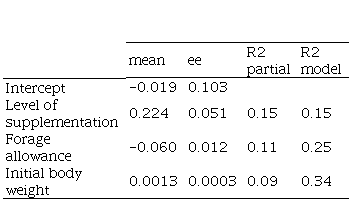
The multiple linear regression model allows us to predict the adga considering the abovementioned parameters. It is possible to evaluate whether or not supplementation is appropriate with this estimate and knowing the price of the concentrate and the produced animal bw. As an example, calves of 160 kg of bw, in winter, managed with a fa of 2.5% bw and supplemented with energy concentrates at 1% of bw would achieve an agda of 0.26 kg/day. This value is similar (0.25 kg/day) to that reported by Simeone and Beretta(51) under these management and feeding conditions. With this value, assuming a price of usd 1.8 per kg of bw produced, a daily intake of 2 kg of supplement (fresh base) at a price of usd 190 a ton, supplementation would be convenient since the result is positive (usd 0.092/calf.day = 0.26 kg /day * usd 1.8/kg of bw produced – 2.0 kg supplement * usd 0.190/kg supplement). In 100 days of supplementation, a feeding margin of usd 9.2/calf would be achieved.
In the studies evaluated in this research, the relationship that exists between fa and adg for the different categories and seasons of the year is, in general, quadratic, whereas the fa increases in cultivated pastures, the adg of beef cattle increases, but with decreasing rates. The inclusion of additional parameters such as initial body weight and supplementation with energy concentrates or silages at fa and season of the year allows predicting the expected adg of the animals under a wide range of feeding alternatives, evaluating the most convenient for the production system.
Considering parameters such as fa, season of the year, initial body weight and type of cultivated pasture allows estimating the fdmi with greater precision, a key variable to determine the production efficiency (fdmi/adg) in grazing systems. Finally, the prediction of the adga using the parameters of the multiple linear regression allows evaluating the convenience of supplementation, considering the price of the concentrate and the produced bw.
Author contribution statement: JM Clariget:
Conceived and designed the analysis, collected the data, performed the
analysis, and wrote the paper.
OM Lema:
Contributed to data or analysis tools, and performed the analysis.
A La Manna: Conceived and designed
the analysis, and contributed to data or analysis tools.
E Perez: Collected the data.
G Banchero:
Conceived and designed the analysis, contributed to data or analysis tools, and
wrote the paper.
E Fernández: Contributed to data or
analysis tools, and wrote the paper.
Editors: The
following editors approved this article.
Gabriel
Ciappesoni (https://orcid.org/0000-0002-0091-3956)
Instituto
Nacional de Investigación Agropecuaria (INIA), Montevideo, Uruguay. // Mariana
Carriquiry (https://orcid.org/0000-0002-1600-2591)
Universidad de la República, Facultad
de Agronomía, Montevideo, Uruguay
http://agrocienciauruguay.uy/ojs/index.php/agrociencia/article/view/107/766 (pdf)
jclariget@inia.org.uy





n = number of observations; ADG = average daily gain (kg/day); FA = forage allowance (kg of DM/100kg body weight/day); BW = body weight; NV = nutritional value (scale 1 – 5; described in Table 1).

n = number of observations; ADGa = “additional” average daily gain (kg/day); BW = body weight; FA = forage allowance (kg of DM/100kg body weight/day); Suppl. = supplementation.

n = number of observations; ADG = average daily gain (kg/day); ADGa = “additional” average daily gain (kg/day); FA = forage allowance (kg of DM/100kg body weight/day); BW = body weight; NV = nutritional value (scale 1 – 5; described in Table 1); Suppl. = supplementation.





